 |
surfresearch.com.au
newspapers : 1947
|
Newspapers : 1947.
|
|
|
|
|
| home | catalogue | history | references | appendix |
 |
surfresearch.com.au
newspapers : 1947
|
|
|
|
|
|
| The Newcastle Sun 7 January 1947, page 7. Dog
"Doubler-Banks"
SURF PALS. When Westley Holdhouse, of Maroubra, Sydney, goes for a surf, his spaniel, 'Checkers,' keen to ride the breakers on a surf board goes with him. 'Checkers' is a veteran and has been riding on surf boards for two years. Here he is shown coming in on a breaker. |
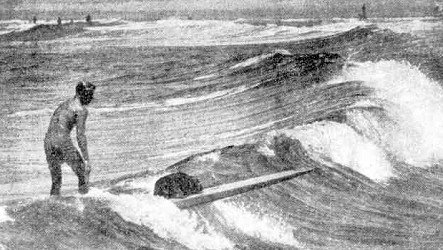 |
| The Australian
Women's Weekly 18 January 1947, pages 18-19. SURF
LIFESAVERS EARN THEIR PLACE IN THE SUN
SURF SKI riders
start in race at
Maroubra, N.S.W.
This kind of ski-ing is exciting. |
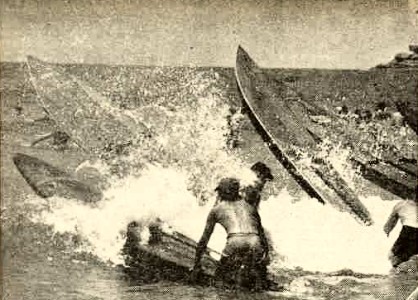 |
| The
Australian Women's Weekly 18 January 1947, page 18. BOARD
RIDING at Manly, N.S.W.
Each club has many enthusiastic board-riders. This picture was taken by Ray Leighton, of the Manly Club, one of the Association's honorary official photographers, the rest by staff photographer Jack Hickson. Trove 1947 'SURF LIFESAWERS EARN THEIR PLACE IN THE SUN', The Australian Women's Weekly (1933 - 1982), 18 January, p. 18. , viewed 16 Jul 2016, http://nla.gov.au/nla.news-article47506145 |
 |
| The Argus Melbourne, 27 January 1947, page 3. MISS NGAIRE CLARKSON CAPTURED THE SPIRIT of the holiday week-end on her surf-board at West St Kilda on Saturday. Trove 1947 'BRITISH SOLDIERS' "HARSH TREATMENT" IN YUGOSLAV GAOL', The Argus (Melbourne, Vic. : 1848 - 1957), 27 January, p. 3. , viewed 16 Jul 2016, http://nla.gov.au/nla.news-article22404737 |
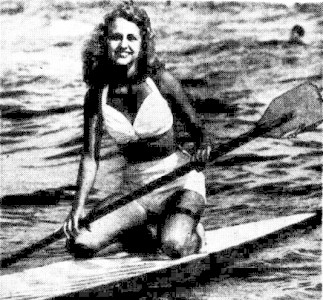 |
| The Sun Sydney, 2 February 1947, page 11. SPORTS
SECTION
...Duck
takes to winter water
Manly surfboard star, Roger Duck, longs for the winter months because he says the summer waves are mere ripples. During winter Duck and many other surf-board riders shoot the breakers regularly."We hear if the waves are big by 'bush telegraph' and all rush down to the beach," Duck says. in niiwci it's colder on the board , than in the surf, so the riders don warm pullovers and old hats. Duck, by the way, still suffering' from housemaid's knee, caused by constant kneeling on the board. |
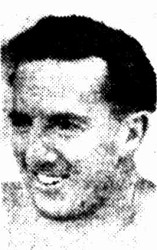 |
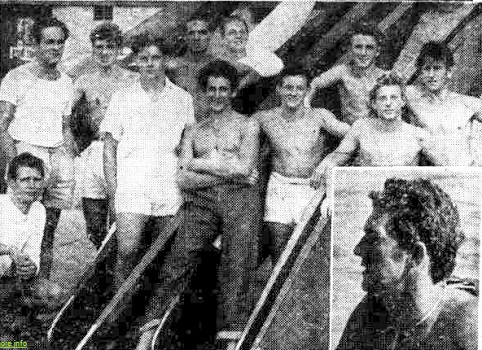
| The
Courier-Mail Brisbane, 7 April 1947, page 8. SPORTS
... K. SAWYER
(North Bondi) left, winner of the surfboard title;
[and L. Cottman (W. Australia), who took the junior belt race] at the national surf championships at Coolanaatta yesterday. Trove 1947 'Courier-Mail Sports—1', The Courier-Mail (Brisbane, Qld. : 1933 - 1954), 7 April, p. 8. , viewed 16 Jul 2016, http://nla.gov.au/nla.news-article49327200 |
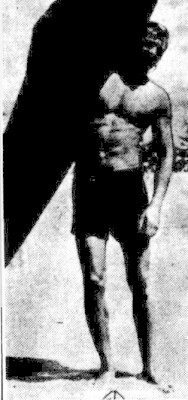 |
| The Sun Sydney, 7 November 1947, page 4. It's Not All Glamor For The
Surfboard Boys
By Bob Graves. FIFTEEN years ago surfboard riding on Sydney beaches was considered a playboys' pastime; now the Surf Life Saving Association has taken official interest in it. The sport has Boomed. More surfboards than ever before will appear on beaches this season, but they won't , all be used for pleasure. Most of surf clubs are now using boards as part of the standard rescue gear, and each patrol will have an experienced board-rider on hand in case he is needed for a long distance rescue. Club officials believe that boards will play a major part in rescues where the victim is washed hundreds of yards beyond the reach of lines. This was proved last season notably at Maroubra, where surf board Captain Frank Adler paddled 600 yards through huge seas to rescue a youth carried out on a rubber float. Adler's experience taught club officials at Maroubra and other open beaches where seas are big and rough, that the board is invaluable. |
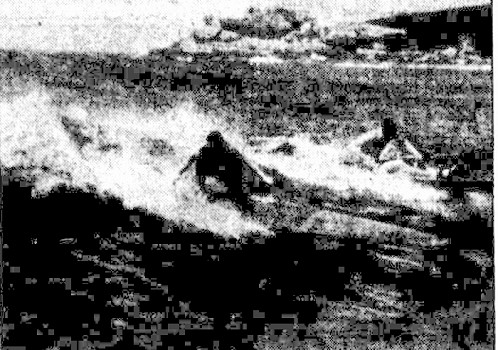 CRACKING
A WAVE.
Surfboard rider and surf skier groove down a big wave. |
When Ironing Boards Took To The Waves
By
PATRICIA
GILMORE
WIVES and
mothers of many "board men" (surf-board riders) will reap
some satisfaction from the fate of the first surfboard to be
imported to Australia.
Sent to Mr.
C. D. Patterson in 1912 from Honolulu, this nine-feet piece
of redwood was launched with considerable ceremony, but it
ended in the Patterson household as an ironing board!
A few men,
however, who saw the initial tryout and had read about the
success the Hawaiians had with such toys, were inspired to
make boards themselves.
Jack
Reynolds, Norman Roberts, and "Looney" Walker (nicknamed
"Looney" after he had dived into the water to retrieve the
bait for his fish hook while other fishermen managed to
catch the shark that was cruising around before it got him),
went into a conference with Les Hynes (a builder at North
Steyne) on the shape these boards were to take.
They were
to have ordinary gothic shaped noses, about 1 ½ inches
thick, and a flat top and bottom with rounded edges.
This design
indicated that the only waves these early enthusiasts
thought "takeable" were "broken waves" at low tide.
This was
all changed when, in 1914, the Australian Swimming
Association decided to invite Duke Kahanamoku to this
country—as a swimmer.
While here,
he was asked to give an exhibition of surfboard riding.
HAVING no
board, he picked out some sugar pine from George Hudson's,
and made one.
This
board—which is now in the proud possession of Claude
West—was eight feet six inches long, and concave underneath.
Veterans of the waves contend that Duke purposely made this surfboard concave instead of con- vex to give him greater stability in our rougher (as compared with Hawaiian) surf.
Duke
Kahanamoku was asked to select the beach where the
exhibition would be given.
He chose
Freshwater (now Harbord).
It was in
February, 1915, that the Australian board enthusiasts had
their first opportunity of seeing a "board expert" on the
waves. There was a big sea running, and from 10.30 in the
morning until 1o'clock Duke never left the water.
HE showed
the watchers all the tricks he knew, sliding right across
the beach on the face of a wave.
Demonstrating
the
ease with which he could manage with a passenger, he took
Isabel Letham (still a resident at Harbord) out with him,
and they would come right into the beach with incomparable
grace and precision.
One young
aspirant watched breathlessly.
He was
16-year-old Claude West. He watched everything Duke
Kahanamoku did.
When Duke
came out of the water, he asked him endless questions.
The result
was that Duke taught him all he knew, and within a month the
pupil had become proficient in paddling, in catching a green
unbroken wave, at judging the correct time to catch a wave,
and at selecting the right wave for the surfboard.
Duke had explained to him that before attempting to shoot green waves on a board it was essential first to learn how to paddle and balance a board in deep water.
When one Australian had learned the art, others became interested and soon Tommy Walker, Geoff. Wylde, Steve Dowling, "Busty" Walker, Billy Hill, Lyle Pidcock, and Barton Ronald began to make boards similar to the one Duke Kahanamoku had made.
Official
approval was given to the use of surfboards when the Surf
Life Saving Association decided to include surfboard
exhibitions at the various surf carnivals, and Claude West
was co-opted to give demonstrations at carnivals all along
the coast.
He won the
championship at these exhibitions for 10 consecutive years.
With more
people becoming interested in surfboard riding, new names
and new ideas came forward.
"Broaching"
the wave was an idea invented by "Busty" Walker and
interested surfboard riders soon adopted the principle of
swinging the board around quickly, which provided better
control in a heavy "dumping" wave.
"Snowy"
McAllister won the championship in 1925.
He made the
first hollow board somewhat similar in shape to the first
solid one (Claude West had actually made a hollow board
earlier—in 1918—but it was based on a different idea from
that of McAllister's).
Quite early
youthful surfboard riders had decided that for speed they
must have less weight in their boards and more buoyancy.
To achieve
this, Claude West had "hollowed out" a solid piece of
redwood, but he struck trouble when he found that the water
came in very
freely through sun cracks.
The board
was scrapped.
A surfboard
rider of long experience—Lou Morath—considers that Claude
West had no equal on the solid board.
Indeed, many
claimed that West had "suckers on his feet" because no wave
and no sea could toss him!
Now
approaching 50 years of age, West has adopted the hollow
board and surfs on it whenever the waves are "on."
ABOUT the
time the Surf Life Saving Association adopted surfboard
races instead of surfboard "exhibitions," the surfboard
began to come into disrepute on beaches.
Surfers
claimed they were dangerous and municipal councils were
feeling that something should be done about banning them.
The Manly Council, in particular, was of the opinion that a regulation should be introduced to prohibit their use, until some council members at South Steyne witnessed one of the most amazing rescues ever seen.
A party of
five surfers were carried out in a very rough sea.
The surfboat
was manned but capsized twice in trying to get out.
Claude West
slammed his board into the water, battled out from the
corner of South Steyne, and picked up the surfer who was in
the worst
shape.
He cracked a
"howler" with his patient in front of him and deposited him
on the beach before the boat had been righted to make a
third attempt at rescue.
Again West sallied forth and another and another of the surfers was brought in.
The council made no move to ban surfboards!
Now the Surf Life Saving Association, surf clubs, and members realise the immense help surfboards, manned by expert riders, can be in rescue work when seas are dangerous and difficult.
Even if that were not so, the fact that a good green wave means more to most boardmen than wife, home or family suggests that Authority would have been hard pressed to make any "prohibition" effective.|
|
|
|
|

| home | catalogue | history | references | appendix |